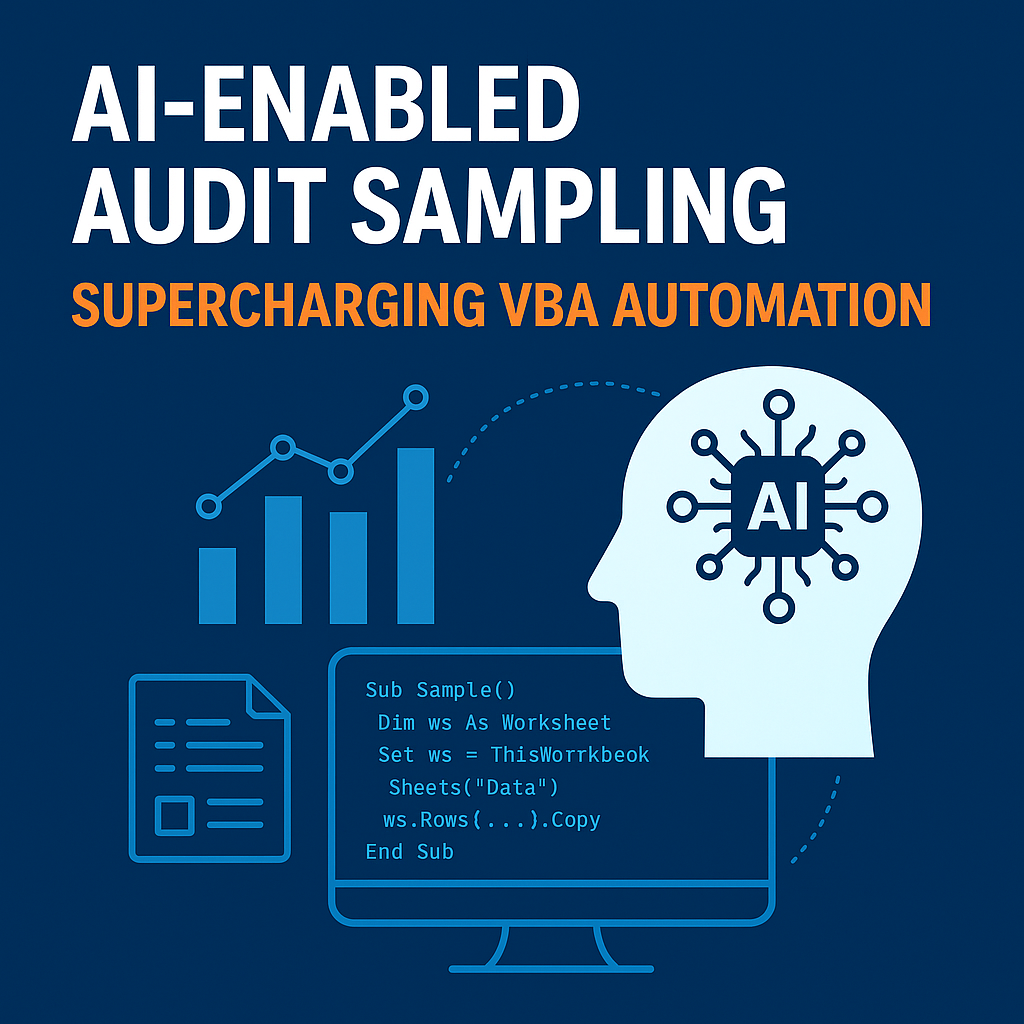1. The AI Revolution in Audit Sampling
The integration of Artificial Intelligence into audit sampling is redefining how Chartered Accountants approach statistical sampling, automating the creation of VBA code that would traditionally require manual scripting. By simply explaining the data layout and desired sampling method—whether Random, Stratified, or Risk‑Based—auditors can generate Excel macros with ease, boosting productivity and precision. The capabilities stretch further into Predictive Sampling, where risk scores guide the selection of high‑risk transactions automatically. When embedded with best practices and prompts, AI can deliver customized, error‑free audit samples in minutes.
2. Key Benefits: Efficiency, Flexibility & Embedded Controls
This AI‑powered VBA automation brings multiple advantages:
- Speed & Efficiency: Time‑consuming manual coding becomes obsolete. AI swiftly generates tailored sample‑selection macros.
- Greater Accuracy: Sampling errors drop significantly, improving audit quality and enabling more representative and scalable samples.
- Continuous Monitoring: Auditors can embed “continuous auditing” macros to flag high‑risk transactions in real time, eliminating dependency on periodic reviews.
- Customizability: Every business has unique data—AI allows sample selection logic to be molded per client, industry, or risk profile.
These benefits reflect broader AI‑audit trends: leveraging full populations for anomaly detection and using AI for powerful risk prioritization and audit insights. For example, AI now allows auditors to analyze entire datasets rather than relying on limited samples, enhancing accuracy and responsiveness .
3. AI in Audit: Broader Applications and Continuous Innovation
Beyond VBA automation, AI is transforming audit workflows in several key areas:
- Document Analysis & Data Extraction: Tools powered by NLP can parse contracts, invoices, and reports—structuring data and flagging anomalies—dramatically accelerating work .
- Enhanced Sampling Design: AI‑driven methods for selecting stratum boundaries (e.g., via Excel’s Solver tool) have shown up to a 40 % improvement in precision for stratified sampling .
- Fraud Detection: Deep learning techniques are being explored to generate representative and interpretable samples from journal entry datasets, unlocking intelligent, data‑rich audit sampling
- Continuous Monitoring & Customizable Solutions: AI supports real‑time anomaly detection and adaptable audit algorithms that can be redefined per client or use‑case .
4. Ethics, Oversight and Professional Assurance
AI’s promise is tempered by important considerations—especially given the auditor’s duty of confidentiality and professional skepticism:
- Data Privacy & Prompt Caution: When using AI to generate code, sensitive data should never be input explicitly. Auditors must limit prompts to metadata (e.g., column names) and not client‑specific details.
- Human‑in‑the‑Loop Governance: Despite AI’s power, human oversight remains essential—auditors must validate AI‑generated logic, debug outputs, and apply judgment where AI lacks context .
- Model Transparency & Ethical Use: With concerns around algorithmic bias and opaque AI logic (the “black box” issue), firms should adopt tools with explainability and governance mechanisms in place .
5. The Road Ahead: Skills & Adoption for CA Professionals
To harness AI in audit effectively, chartered auditors should foster these capabilities:
| Skill / Focus AreaWhy It Matters |
| Prompt Crafting & VBA Literacy | Enables precise AI-led macro generation and automation. |
| Oversight & Validation | Ensures AI outputs are accurate, ethical, and audit-ready. |
| Continuous Monitoring Design | Creates proactive audit systems rather than reactive ones. |
| Ethical AI Governance | Embeds trust, compliance, and accountability in AI adoption. |
Firms that invest in these competencies will elevate audit practice—moving from repetitive tasks to strategic, value-added assurance.
Conclusion
AI-enabled audit sampling—powered by dynamic VBA code generation and continuous monitoring—is accelerating the evolution of auditing. By blending accuracy, efficiency, and ethical oversight, this approach empowers CAs to focus on judgment and risk in the audit process. As AI continues reshaping assurance, the institute and the chartered community must stay adaptive, ensuring technology serves quality, transparency, and professional integrity.
Source:ICAIChat GPT






